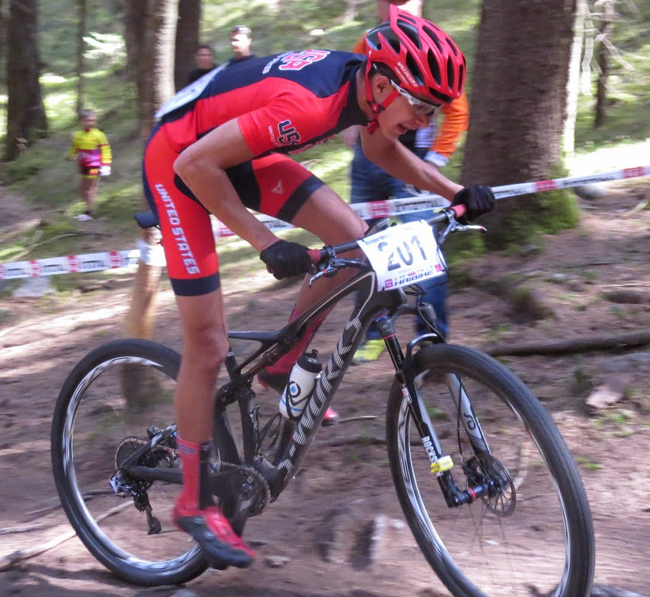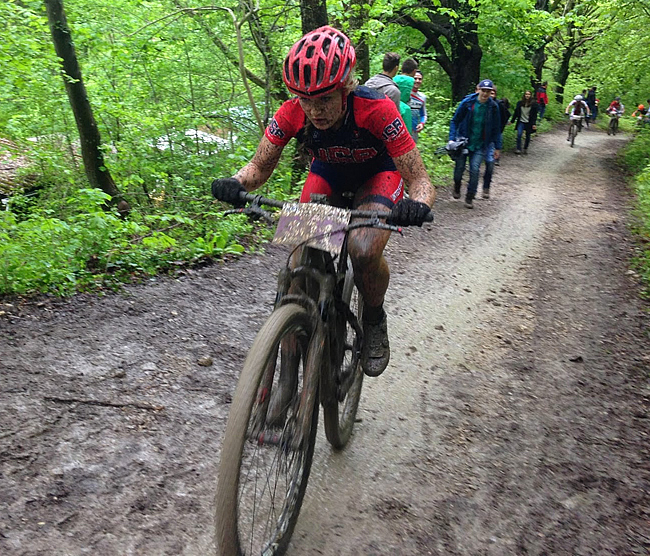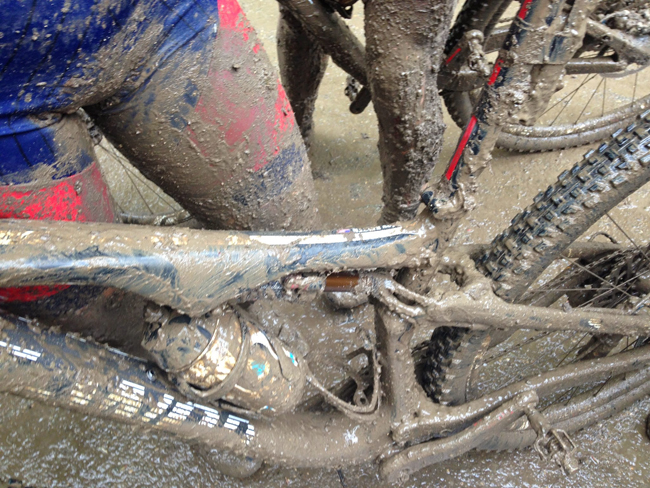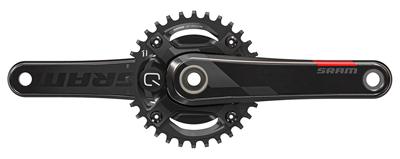The Quarq Factor Criteria
At Whole Athlete, we use a standard called Maximal Steady State (MSS), a real-world performance threshold of 20-30 minute peak power and heart rate which reflect readily measurable and repeatable criteria confirmed with either a simple field test or through the validated MSS testing protocol used at the Whole Athlete Performance Center.
During a mountain bike race, a better representation of the highly variable workload over time is normalized power since it represents the physiological demands by estimating the power that could have been maintained had it been constant. For each rider, normalized power as a percentage of their individual MSS gives the value relative meaning since each person's specific power levels can be quite different. We will keep each rider's actual power data confidential, yet still provide a representation that is meaningful and informative.
The Euro Effect
Four of our Junior 17/18 riders had the opportunity to race in Austria and Germany this past month, competing in the highest level Junior Series UCI races. By gathering power data throughout, we found that the depth of the fields, high level of competition, and nature of the courses all combined to determine power demands.
The most common factor in contrast to XC races in the US is that high level European XC races require a higher initial output (1 to 2 min peak power) to be competitive with the fastest riders, specifically on the start loop (Table 1). But much like the various US courses, the relative punchiness or steadiness of the climbs dictates much of the distribution of power.
The most effective strategy was being able to achieve a good position on the start loop without going out too hard, then maintain consistent and strong laps throughout, especially the final lap.
At the Haiming, Austria event, the course featured many steep, punchy climbs with little place to recover, whereas in Heubach, Germany the course was basically a single stair-step climb and descent each lap. The climbing profile differences were apparent in time in ranges around and above Maximal Steady State (MSS) power. A significantly larger amount of time spent at a higher supra-threshold (>140% MSS power) range on the punchy Haiming course, while in Heubach the time between 100-140% of MSS was greater given the more sustained climb (Table 2).
Tables 3-6 compare the time spent at MSS and above for each rider among all four US and European Spring Junior UCI events.
Table 1: Haiming, Austria & Heubach, Germany Junior UCI Series -
Men and Women
Normalized Power as Percentage of Maximal Steady State
Haiming, Austria
|
|||||||
| Start Lap | Lap 1 | Lap 2 | Lap 3 | Lap 4 | Lap 5 | Race Avg | |
| Athlete 1 | 114% | 99% | 91% | 90% | 88% | 90% | 94% |
| Athlete 2 | 122% | 109% | 90% | 88% | 85% | 96% | 94% |
| Athlete 3 | 105% | 91% | 76% | 76% | 76% | N/A | 83% |
| Athlete 4 | 129% | 94% | 85% | 75% | 78% | N/A | 86% |
Heubach, Germany
|
|||||||
| Athlete 1 | 122% | 95% | 95% | 94% | 97% | N/A | 103% |
| Athlete 2 | 113% | 109% | 94% | 93% | 100% | N/A | 99% |
| Athlete 3 | N/A | 83% | 78% | 80% | N/A | N/A | 80% |
| Athlete 4 | N/A | 106% | 93% | 98% | N/A | N/A | 99% |
Table 2: Haiming, Austria & Heubach, Germany Junior UCI Series -
Men and Women
Time at Maximal Steady State (MSS) and Supra-Threshold Power
| MSS: | 100 - 120% | 120-140% | >140% | |||
| Haiming | Heubach | Haiming | Heubach | Haiming | Heubach | |
| Athlete 1 | 7:00 | 12:30 | 10:40 | 14:00 | 9:30 | 3:30 |
| Athlete 2 | 8:30 | 13:00 | 12:00 | 11:00 | 10:30 | 3:30 |
| Athlete 3 | 6:25 | 12:00 | 5:15 | 7:00 | 8:00 | 5:00 |
| Athlete 4 | 8:55 | 13:40 | 5:40 | 5:25 | 6:30 | 4:30 |
Table 3: Comparison of US and European Spring Junior UCI Series - Athlete 1
Time at Maximal Steady State (MSS) and Supra-Threshold Power
| MSS: | 100 - 120% | 120-140% | >140% | Climbing |
| Fontana | 7:14 | 11:35 | 9:30 | Mixed |
| Bonelli #2 | 6:42 | 10:00 | 10:30 | Short/ Punchy |
| Haiming | 7:00 | 10:40 | 9:30 | Short/ Punchy |
| Heubach | 12:30 | 14:00 | 3:30 | Sustained |
Table 4: Comparison of US and European Spring Junior UCI Series - Athlete 2
Time at Maximal Steady State (MSS) and Supra-Threshold Power
| MSS: | 100 - 120% | 120-140% | >140% | Climbing |
| Fontana | 8:00 | 11:30 | 9:15 | Mixed |
| Bonelli #2 | 5:15 | 10:15 | 13:30 | Short/ Punchy |
| Haiming | 8:30 | 12:00 | 10:30 | Short/ Punchy |
| Heubach | 13:00 | 11:00 | 3:30 | Sustained |
Table 5: Comparison of US and European Spring Junior UCI Series - Athlete 3
Time at Maximal Steady State (MSS) and Supra-Threshold Power
| MSS: | 100 - 120% | 120-140% | >140% | Climbing |
| Fontana | 9:00 | 7:25 | 9:15 | Mixed |
| Bonelli #2 | 9:50 | 7:50 | 12:00 | Short/ Punchy |
| Haiming | 6:25 | 5:15 | 8:00 | Short/ Punchy |
| Heubach | 12:00 | 7:00 | 5:00 | Sustained |
Table 6: Comparison of US and European Spring Junior UCI Series - Athlete 4
Time at Maximal Steady State (MSS) and Supra-Threshold Power
| MSS: | 100 - 120% | 120-140% | >140% | Climbing |
| Fontana | 9:20 | 6:10 | 8:15 | Mixed |
| Bonelli #2 | 10:05 | 6:25 | 7:00 | Short/ Punchy |
| Haiming | 8:55 | 5:40 | 6:30 | Short/ Punchy |
| Heubach | 13:40 | 5:25 | 4:30 | Sustained |
The Quarq Factor Phase 3 - Preview
On tap for the Quarq Factor Project are three more UCI Junior events in the US, including the Missoula ProXCT, Colorado Springs ProXCT, and the National Championships at Mammoth Mountain, CA. Both Colorado Springs and Mammoth are at high elevation and will reveal how the thin air affects power for both sea level dwellers relative to those from elevation towns. Stay tuned!

The Haiming course was dry, but with steep and punchy climbs.

The main climb in Heubach required a high, steady output.

Mud played a role in the challenging race in Germany.
About the Quarq Factor Project
A longtime tool for road racers worldwide, the powermeter has become a valuable asset for the mountain bike as well with the release of the Quarq XX1. For the 2015 season, the Whole Athlete/Specialized Team has partnered with Quarq Powermeters to employ this powerful tool in an innovative project called The Quarq Factor.

By analyzing race data throughout the year, the team will determine optimal pacing strategies, measure power requirements of each course, and explore what it takes for each rider to continue on an optimal development path with greater training specificity.
Whole Athlete/Specialized will publish an analysis of the data periodically to demonstrate the power of the Quarq for competitive cyclists looking to take their racing to the next level.

No comments:
Post a Comment